Last year my daughter gave me several basalt intaglios for my birthday (she has the “collector bug”, like myself, so we feed each other’s habits). I gave each of them a thorough inspection, secure in my superficial knowledge that they were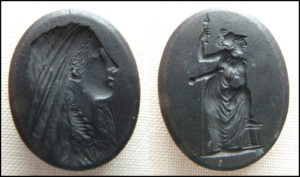 Wedgwood basalts or imitations. I added their descriptive information to my list of acquisitions and placed them in the vintage wooden machinist’s tool chest with the others I have collected. One was a profile bust of a lovely young woman with flowing hair. On the opposite side is a figure that is probably Athena standing with a spear and sword.
Wedgwood basalts or imitations. I added their descriptive information to my list of acquisitions and placed them in the vintage wooden machinist’s tool chest with the others I have collected. One was a profile bust of a lovely young woman with flowing hair. On the opposite side is a figure that is probably Athena standing with a spear and sword.
Little did I realize at the time that this one stone would cause me to take the next step in collecting — researching the history of an individual intaglio.
At some later date I was surfing the web looking for information on Wedgwood basalts. Naturally, I went off on a tangent and became interested in a contemporary of his, a modeler by the name of James Tassie. Thanks to Google Books and the Internet Archive, I found the entire content of a two volume catalog of Tassie pastes (A DESCRIPTIVE CATALOGUE OF A GENERAL COLLECTION … BY JAMES TASSIE, MODELLER; arranged and described by 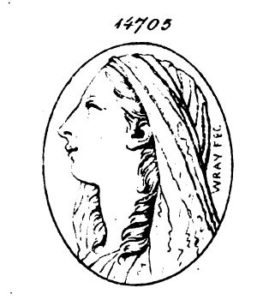 R. E. RASPE 1791, Vol I — https://archive.org/details/descriptivecatal01rasp and Vol II — https://archive.org/details/gri_33125008808459 ). While perusing the catalog, I came upon a drawing in one of the plates that looked familiar. It took a little time to figure out where I had seen it, but I soon realized it was the young woman on the basalt.
R. E. RASPE 1791, Vol I — https://archive.org/details/descriptivecatal01rasp and Vol II — https://archive.org/details/gri_33125008808459 ). While perusing the catalog, I came upon a drawing in one of the plates that looked familiar. It took a little time to figure out where I had seen it, but I soon realized it was the young woman on the basalt.
The catalog I mention above is a complete listing of all 15,800 pastes in the Tassie collection. James Tassie, who was active during the mid 18th century, made replicas of the gems from many, if not most, of the European carved gem cabinets (collections). He then made copies available to the public (for a price, of course), thus further popularizing the collecting of engraved gems beyond the aristocracy.
After I found the intaglio in my collection the key to finding additional information was the number above the drawing in the catalog, 14705. This led back to the description of the object in the text portion of the publication –
From A Descriptive Catalogue…by Raspe, Vol II p758
“14704] — A Most Beautiful Character.
OTPAIOS GnOIGT (Greek, see orig.). The most able masters have sometimes, inconsiderately, in a very extraordinary manner deceived themselves. Wray thought that he had in executing this, engraved an Alexander, which after all, is only the head of the fair Laundress.
14705 Chalcedony. Mr. Tassie, The fair Laundress in a veil; changed naturally enough into a Mary Magdalen. WRAY. FEC. Plate LVII.
Ditto, with diadems or frontlets ; the hair in the Greek or Roman taste.”
I’ve included the description for the previous entry, No. 14704, because of its relevance to my stone, No. 14705. These entries clearly identify the image as being Mary Magdalen and the engraver Wray (Robert Batemen Wray, 1715 – 1779). The references to the “fair Laundress” opened a whole other mystery to be solved. It further indicated that the original engraved stone was, in fact, in Tassie’s own personal collection.
Cross reference tables in the publication verified the information and also provided further insights to Wray’s works by indicating which of his pieces had been copied by Tassie and which of Wray’s original intaglios Tassie had in his personal cabinet.
Upon further reading I found that Wray was well acquainted with Tassie. Tassie included original pieces by Wray in his catalogs of works for sale.
Searching with hopes of finding a better likeness of the original Magdalen by Wray, I came upon a treasure trove of pictures of the entire Tassie collection, again, all 15,800 of them. They’re located at http://www.cvaonline.org/gems/tassie/default.htm (This website is The Classical Art Research Centre which, according to its home page, leads and supports research on ancient art. At its heart is the Beazley Archive, which includes the world’s largest collection of images of ancient figure-decorated pottery. The Beazley Archive is a part of the University of Oxford’s Ashmolean Museum .) This collection taken together with Raspe’s Catalog of Tassie’s works is a “Rosetta Stone” for collectors researching the history of specific intaglios. More on that in another post. Browsing to No. 14705, I found the picture of the Tassie reproduction – identical to my basalt!
Two images are shown because the cvaonline pages have two light sources for each image (those guys are smart!)
Two questions remained. Who produced the basalt that I had and what’s this “fair Laundress” thing all about?
As far as I can tell, Tassie only produced copies in paste (a form of glass) and Sulphur; he didn’t make them in basalt clay, so my stone wasn’t one made by Tassie. It was no doubt manufactured from a mold, either an original one by Tassie (he was known to sell his molds to other manufacturers such as Wedgwood), one made from another cast taken from Wray’s original work, or from a copy made by another modeler. There was a lot of copying, imitation, and, let’s call it as it was, forgery going on at that time. Since the stone is two faced and there is no other indication of its origin, it would be virtually impossible for me, with my limited knowledge, to determine its manufacturer. I had to leave it at that.
The “fair Laundress” thing was fairly easy to figure out. Raspe, the author, was “dissing” Wray, the engraver, for engraving a very similar image several times and naming each of them with different titles. Here are the descriptions for Raspe Nos. 14701 – 14705.
And here are the pictures from the British Museum Tassie images, 14701 to 14705 left to right.
I guess when you got good at engraving an image (except for the end of the nose on 14702) you wanted to keep at it.
I hope that you too have had some fun by looking into the history of an intaglio.
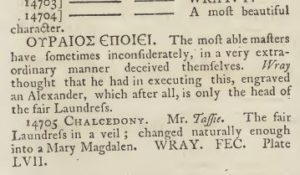
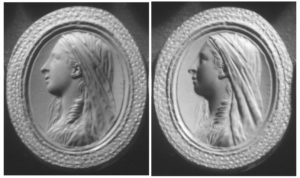
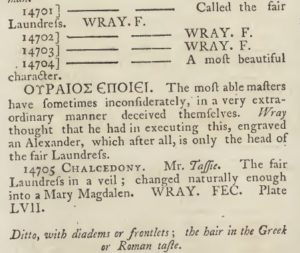

Leave a Reply